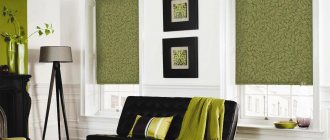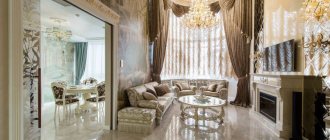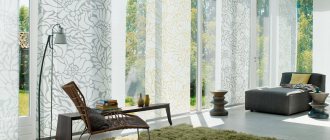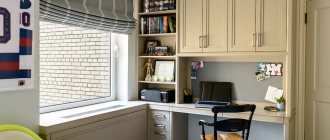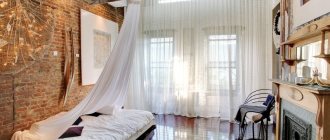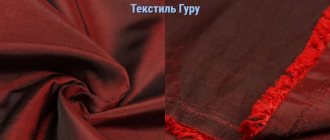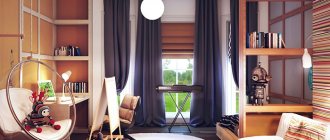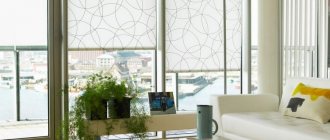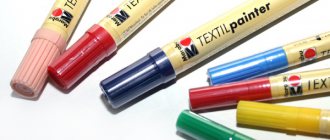Taffeta is a fabric with a glossy sheen., woven in a plain weave from natural, artificial or mixed yarns. You can learn more about curtains consisting of single threads in this article. This fabric was first made in Persia from natural silk. Then the production of this material was organized in Byzantium, and cotton or blended yarn was used for its manufacture.
Modern fabric is usually made from tightly spun synthetic threads, usually consisting of polyester or acetate.
This is a dense fabric that holds its shape well . A type of taffeta material - shanzhan - has an interesting iridescent color.
Advantages and disadvantages of taffeta curtains
This fabric has a very wide range of applications, as it has a chic appearance, good dimensional stability and a dense texture. Draperies made of majestic velvet look no less attractive, about which you can learn more here.
The main advantages of the fabric are as follows:
- has water-repellent properties;
- lends itself well to draping;
- looks solemn, elegant and noble;
- quite strong and durable.
The disadvantages of taffeta include the need for delicate care, since when it is strongly crumpled, folds form, which are very difficult to get rid of.
This fabric shrinks when washed in hot water , so it is washed with gentle detergents at a water temperature of no more than 30 degrees.
When drying, curling should be avoided, and ironing should be done at the minimum temperature setting of the iron from the wrong side and through damp gauze.
Taffeta made from natural fibers, like linen, silk, and cotton, allows air flow well, is environmentally friendly, and has dust-repellent properties; those made from synthetic threads are stiffer, lighter and denser.
Compound
Silk taffeta is considered the most valuable and is made according to all the rules. It was from silk threads that canvases were originally made. Then cotton was added to the fabric. Currently, weaving factories produce taffeta from polyester, acetate, and viscose. The synthetic composition is inherent in lining fabrics. And natural varieties are used for tailoring luxury clothing.
Taffeta jacquard is one of the most expensive and elegant fabrics. In this case, the composition of the material can be anything, the main feature is the presence of a jacquard pattern. It is obtained by weaving threads of different colors, which distinguishes canvases with printed patterns. If we talk about the composition, then dense jacquard taffeta with a silk base is the most valuable. Blended cuts are more available: with cotton, viscose, synthetic fibers. Their ratio in matter is not the same.
Types of taffeta curtains
Taffeta is a versatile fabric. It is suitable for sewing curtains of both the first and second plan.
For example, chameleon taffeta wonderfully softens curtains with iridescent shine and lightness. From this material you can choose curtains for the bedroom, the living room, the office, and even select curtain models for the kitchen.
Using this fabric you can create a window interior in any style. For example, fabric in bright and rich colors with a metallic sheen will look good in the kitchen. You can learn more about the rules for selecting curtains by color here.
Textiles in pastel shades will fit perfectly into the classic interior of the living room.
You can sew striped Roman blinds from taffeta.
Modern taffeta can be any shade, plain or embroidered. It can be used in any interior style, from modern and baroque to high-tech or even fusion.
When sewing curtains from such material, you should remember that the fabric slides and bunches strongly under the sewing stitch .
Punctures with a sewing needle remain noticeable, so it is better to entrust sewing taffeta curtains to professionals or buy ready-made curtains.
Generality of composition
The interior of the living room is designed to be cozy and comfortable. Therefore, there is always a lot of textiles in a themed room:
- Flooring;
- Tablecloth for coffee table;
- Upholstery soft set;
- Bedspreads for upholstered furniture;
- Window curtains.
It is desirable that all fabric products, including curtains for the living room, have a similar color scheme. An appropriate approach will emphasize the generality of the composition and hint at the subtle taste of the owners of the living room.
How to choose ready-made taffeta curtains
This fabric is difficult to sew, it is easy to ruin with poor stitching and is not easy to cut. This is why most buyers prefer to buy ready-made curtains.
Purchasing ready-made curtains has the following advantages:
- no need to wait for them to be made or bother with sewing and cutting;
- curtains have rings or loops for easy hanging;
- You can immediately try them on the window and evaluate the harmony with the interior, and also return them if they don’t fit well;
- Usually, ready-made curtains cost an order of magnitude cheaper than custom-made curtains.
Choosing a cornice
Cornices differ from each other in composition, number of rows and method of fastening. The composition is selected depending on the weight and style of the curtains. If they are heavy, then it is better to hang them on a metal or string cornice. At the same time, don't forget about style.
For example, a wooden supporting base is more suitable for heavy classic curtains than a string one. But the plastic cornice is predominantly hollow. Therefore, it is beneficial to hang light tulle on it.
However, all types of curtain rods are tested for resistance to certain loads, so choosing a load-bearing base according to only one weight of curtains is a controversial undertaking (it is better to pay attention to the composition).
The number of rows is affected by double curtains in the living room, i.e. use of additional curtains or lambrequins. As for fastening, the cornice can be:
- Wall-mounted;
- Ceiling.
The first option is suitable for curtains with eyelets, the second - for curtains with hooks. At the same time, hooks can be hung on rings, which in turn cut into the wall crossbar.
Wall cornice is more popular than ceiling cornice, because... it is easier to install. On the other hand, the ceiling option is good in its own way:
- Firstly, it visually increases the height of the room;
- Secondly, it hides defects on the wall with windows;
- Thirdly, it allows you to decorate windows if the gap between them and the ceiling does not allow installing a wall cornice;
- Fourthly, it shows the curtains in all their glory;
- Fifthly, it reduces the flow of noise and drafts into the living room if the quality of the glazing leaves much to be desired.
Therefore, the ceiling cornice can be called a fairly universal load-bearing base for curtains.
Living room draperies made of taffeta
Using this fabric to decorate your living room, you can create a very romantic, noble and festive interior.
It is suitable both for making first-order curtains (drapes) and for sewing curtains.
This fabric is capable of forming luxurious draperies, so it is perfect for sewing curtains.
Taffeta curtains for bedroom
In a luxury bedroom, double curtains look elegant, where taffeta is the first level curtain. Combining fabric with organza trims, you can achieve the effect of lightness, mystery and romanticism.
Such curtains will look very delightful , but purchasing or sewing them will not be cheap. Or, for example, use translucent chameleon taffeta over a simple opaque plain fabric.
This combination looks unusual and modern.
Care
For taffeta products, care and processing are of utmost importance. The fabric is capricious and can become damaged if not handled correctly. Many taffeta clothing manufacturers recommend professional dry cleaning. But washing taffeta is also possible at home. Usually items are washed by hand, but large items can be put in a washing machine on a delicate cycle with a water temperature of 30ᵒC.
How to properly wash taffeta items? For this purpose, special detergent compositions are used for delicate fabrics: wool and silk. You can use hair shampoo or liquid soap. Stubborn stains are difficult to remove at home. It is also problematic to wash wrinkled taffeta. In these cases, dry cleaning is inevitable.
All types of fabric do not tolerate spinning or twisting. Dry them flat. To iron the product, you need to use gauze or thin cotton cloth and the “silk” or “synthetic” mode, based on the composition of the material. Store the products hung on hangers, preferably in an individual case.
Dear readers of the Tkan.Club website, if you still have questions on this topic, we will be happy to answer them. Leave your reviews, comments, share stories if you have dealt with this material! Your life experience may be useful to other readers.
Decorating windows in the kitchen with taffeta curtains
Roman blinds will look natural in the kitchen. For them, it is better to choose a plain and dense fabric. If the kitchen is made in high-tech style, then curtains with eyelets with a metallic sheen will help add coziness.
A classic-style kitchen with a small window will be decorated with curtains with lambrequins made of taffeta and mesh of the Buff model: two curtains and a two-tier lambrequin, made in the form of a double-sided drapery .
Taffeta curtains are so versatile and diverse that they absolutely do not limit the designer’s flight of imagination.
This fabric is ideal for sewing curtains and interior decoration. With its help, you can create both a feeling of lightness and a sense of solemnity; it always looks noble and expensive.
Linen
Linen helps create a favorable environment. Linen itself is an expensive material; most often it is used in combination with other materials that increase its durability and service life.
Linen also has other positive qualities: it does not deteriorate during washing and dries quite quickly. It has a long service life - up to fifty years. Linen also has a number of disadvantages: it is an easily wrinkled material that can hardly be dyed. There are both dense fabrics and lightweight materials.
